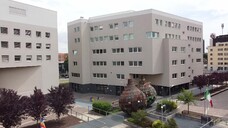Plants native to the Alps are moving to ever higher altitudes and their survival ranges have shrunk as a result of climate change, while alien species are more resistant, according to the results of Italian research led by Lorenzo Marini and Costanza Geppert from the University of Padua, published in the journal of the U.S. Academy of Sciences (Pnas).
For example, the researchers found that in the past 30 years Bromus erectus has moved at a rate of about 3 meters per year and Sorghum halepense, an alien species, has moved at a rate of 4 meters per year.
Conducted in collaboration with Alessio Bertolli and Filippo Prosse of the Rovereto Civic Museum Foundation, the research is based on the analysis of more than 1,400 native and alien species between 1990 and 2019.
Rising temperatures have a strong impact on plants living in the Alps, pushing them to climb in altitude in search of suitable environments for survival. But this movement is slower than the climate change taking place, leading to the gradual reduction of the survival ranges of many plants. By analyzing these changes over the past 30 years, the Italian researchers have seen that this upward shift does not occur in the same way for all species; in fact, native plants have greater difficulty surviving than alien plants, which over the years have found a footing in the Alps following human introduction, but were native to other areas.
In particular, for native species there is in fact a more pronounced reduction at lower altitudes, while alien species are better able to adapt to warm temperatures. The authors say this should prompt the extension of native flora conservation policies even in low-altitude areas, where there is generally less attention to the problem and at the same time more competition from alien species.
"In ecology it is rare to be able to examine data with good spatial and temporal resolution. In this study, we were able to analyze changes in the distribution of more than one million records of 1,479 alpine species over a 30-year period," notes Geppert, of the Department of Agronomy, Animals, Food, Natural Resources and Environment at the University of Padua. "The rapid loss of specific distribution areas of rare plants has occurred in areas where human activities and environmental pressures are high,” adds Marini, who coordinated the study. This "suggests to us that we should also protect some areas downstream and not just the more remote high-altitude areas,” he continued. “What we did was to measure the ability of plant species to compete, including with humans. Alien plants under conditions of disturbance -- by fertilization, removal of resident vegetation for construction of a house, road or parking lot -- are very quick to grow and exploit the resources present, taking them away from other native species. Our study showed that it is precisely in the most anthropized and disturbed areas that alien plants are particularly adept at competing with other species."
For Prosser and Bertolli, "the open areas are in danger of disappearing because in the steepest and most inconvenient areas they are being abandoned, while in the flat areas near roads they are subject to increasingly excessive fertilization and grazing, which result in a trivialization of the floristic component. The danger is that species that are truly unique and valuable to the biodiversity of our Alps will be lost."
Riproduzione riservata © Copyright ANSA












